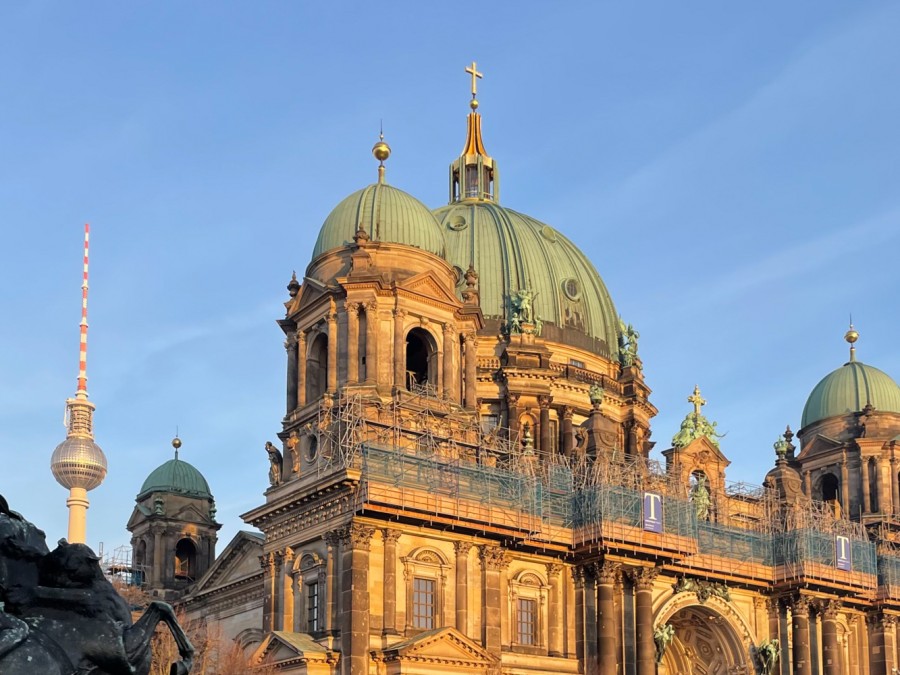What NYU doesn’t tell you: Berlin
If you are studying at NYU Berlin, here are the most important tips for navigating life in the city.
The Berlin Cathedral. (Lena Olson for WSN)
March 27, 2023
“What NYU doesn’t tell you” is a series started by the Abroad desk meant to share advice on the ins and outs of the cities where NYU students study abroad.
Berlin is a vibrant city that has no shortage of things to experience, making it a great site for study abroad. Having access to the academic building in the center of the Prenzlauer Berg district, we can enjoy the city as soon as we leave the classroom. In the first few weeks, though, it can be quite difficult to adapt. From clubbing, to museums, to transit, here are some tips to help you master the city in no time.
The coveted nightlife
One of Berlin’s greatest draws is its vibrant club scene. From techno and sex clubs to American dance nights — and everything in between — clubbing and nightlife can be tons of fun. The culture, however, is very different from that in other countries.
For one, nights out here are often long commitments. The night rarely starts before midnight and easily lasts anywhere from four to 10 or 12 hours. Berghain, a notoriously exclusive club, even sells sandwiches at the bar because some people stay for days. Sometimes, people will even go to bed on a Saturday night and wake up early Sunday morning to hit the clubs.
Berlin is also a city known for anonymity: People feel free to express and experience every part of themselves, and the club culture encourages it. Photos are often strictly prohibited, to the point where bouncers place sticker covers on your phone cameras, with some places confiscating phones at the door.
Clubs are also, for the most part, respectful environments. With such an intense club culture, people come to enjoy themselves, and not to bother others. For example, in dance spaces in other cities, I have found myself being prodded and groped; in Berlin, I do not find myself being bothered at clubs at all. It is a respectful and conscientious culture, which is a bit surprising in light of its intensity.
The richness of Berlin’s day-life
The excitement of Berlin’s nightlife is no secret. What I did not fully realize until coming here, however, is the true depth of culture there is to experience during the day.
Berlin is at the forefront of the museum scene, with over 170. To get the most out of them, I recommend buying a “Jahreskarte der Staatlichen Museen zu Berlin,” available at the ticket counter of museums on Museum Island. For only €25, you get a year of unlimited access to all 17 of the state-owned museums. This allows you to experience so much incredible art, ornate architecture and history, including the Egyptian bust of Nefertiti at the Neues Museum, arguably one of the most important archaeological finds of the 20th century. Alte Nationalgalerie is a great place to start if you are looking for art, or the Altes Museum, which houses Greek antiquities.
Although it has been cold, dark and wet since I arrived here, I always really enjoy the parks as well. Greenspace makes up 40% of Berlin’s land area, meaning there are many beautiful parks to discover in the city. Berlin holds two of Germany’s three largest parks — Tiergarten and Tempelhofer Feld. I am also particularly fond of Victoria Park because of its high hills that provide an incredible view of the city, and the best spot to catch the sunset.
Public transportation
Berlin uses a mixture of above and below-ground trains, buses and trams, and I often use a combination of these means. The trains shut down at 1 a.m. on weekdays, but run 24 hours on weekends. There are also night buses, which is refreshing compared to other cities that aren’t awake all night.
Coming from cities like New York City and London, I expected to pay up front when entering a train station, but this is not the case in Berlin. There are kiosks where you buy and validate a ticket for each journey, though students can get a semester pass from NYU. What is strange is that these tickets and passes are rarely checked — we have RAs who have lived here for years and only been checked once, whereas I have lived here for six weeks and been checked twice. Without warning, non-uniformed people will enter the train, lock the doors and ask to see everyone’s valid ticket or pass. If you have your ticket, nothing happens. If you don’t, you face a fine, up to €60.
In an ever-changing city like Berlin, construction is also inevitable, and public transportation suffers greatly because of it. Things are always delayed, routes are changing and some routes don’t even run. Reliability of transit is not one of the wonderful parts of Berlin.
Traveling outside of Germany
Part of what is so exciting about studying in Berlin is how accessible the rest of Europe is. However, it does not take long to learn that Berlin is a very expensive city to fly into. For example, I got excited about a $67 flight into Madrid just to find that the return flight was $149. If you are hoping to travel often, this price is not all that appealing.
To remedy this, I recommend taking buses and trains, at least on your return to Berlin. I am a huge fan of overnight FlixBuses because of the ease of transport. I got to and from Prague for under $40 on a bus. Going overnight allows you to sleep and bring all the snacks you could want, all while saving a whole lot of money.
Contact Lena Olson at [email protected].
























































































































































